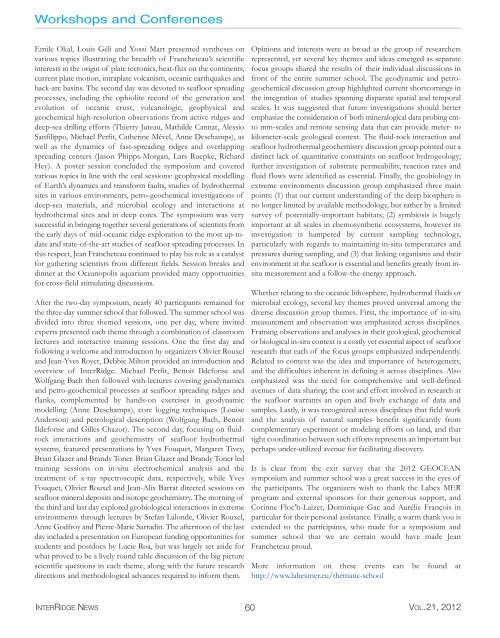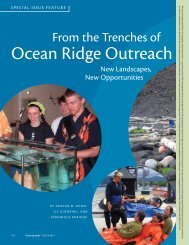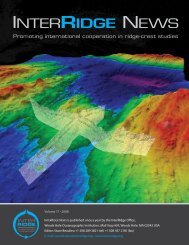Full version, low resolution, 7.5MB - InterRidge
Full version, low resolution, 7.5MB - InterRidge
Full version, low resolution, 7.5MB - InterRidge
You also want an ePaper? Increase the reach of your titles
YUMPU automatically turns print PDFs into web optimized ePapers that Google loves.
Workshops and Conferences<br />
Emile Okal, Louis Géli and Yossi Mart presented syntheses on<br />
various topics illustrating the breadth of Francheteau’s scientific<br />
interests in the origin of plate tectonics, heat-flux on the continents,<br />
current plate motion, intraplate volcanism, oceanic earthquakes and<br />
back-arc basins. The second day was devoted to seafloor spreading<br />
processes, including the ophiolite record of the generation and<br />
evolution of oceanic crust, volcanologic, geophysical and<br />
geochemical high-<strong>resolution</strong> observations from active ridges and<br />
deep-sea drilling efforts (Thierry Juteau, Mathilde Cannat, Alessio<br />
Sanfilippo, Michael Perfit, Catherine Mével, Anne Deschamps), as<br />
well as the dynamics of fast-spreading ridges and overlapping<br />
spreading centers (Jason Phipps-Morgan, Lars Ruepke, Richard<br />
Hey). A poster session concluded the symposium and covered<br />
various topics in line with the oral sessions: geophysical modelling<br />
of Earth’s dynamics and transform faults, studies of hydrothermal<br />
sites in various environments, petro-geochemical investigations of<br />
deep-sea materials, and microbial ecology and interactions at<br />
hydrothermal sites and in deep cores. The symposium was very<br />
successful in bringing together several generations of scientists from<br />
the early days of mid-oceanic ridge exploration to the most up-todate<br />
and state-of-the-art studies of seafloor spreading processes. In<br />
this respect, Jean Francheteau continued to play his role as a catalyst<br />
for gathering scientists from different fields. Session breaks and<br />
dinner at the Oceanopolis aquarium provided many opportunities<br />
for cross-field stimulating discussions.<br />
After the two-day symposium, nearly 40 participants remained for<br />
the three-day summer school that fol<strong>low</strong>ed. The summer school was<br />
divided into three themed sessions, one per day, where invited<br />
experts presented each theme through a combination of classroom<br />
lectures and interactive training sessions. One the first day and<br />
fol<strong>low</strong>ing a welcome and introduction by organizers Olivier Rouxel<br />
and Jean-Yves Royer, Debbie Milton provided an introduction and<br />
overview of <strong>InterRidge</strong>. Michael Perfit, Benoit Ildefonse and<br />
Wolfgang Bach then fol<strong>low</strong>ed with lectures covering geodynamics<br />
and petro-geochemical processes at seafloor spreading ridges and<br />
flanks, complemented by hands-on exercises in geodynamic<br />
modelling (Anne Deschamps), core logging techniques (Louise<br />
Anderson) and petrological description (Wolfgang Bach, Benoit<br />
Ildefonse and Gilles Chazot). The second day, focusing on fluidrock<br />
interactions and geochemistry of seafloor hydrothermal<br />
systems, featured presentations by Yves Fouquet, Margaret Tivey,<br />
Brian Glazer and Brandy Toner. Brian Glazer and Brandy Toner led<br />
training sessions on in-situ electrochemical analysis and the<br />
treatment of x-ray spectroscopic data, respectively, while Yves<br />
Fouquet, Olivier Rouxel and Jean-Alix Barrat directed sessions on<br />
seafloor mineral deposits and isotope geochemistry. The morning of<br />
the third and last day explored geobiological interactions in extreme<br />
environments through lectures by Stefan Lalonde, Olivier Rouxel,<br />
Anne Godfroy and Pierre-Marie Sarradin. The afternoon of the last<br />
day included a presentation on European funding opportunities for<br />
students and postdocs by Lucie Roa, but was largely set aside for<br />
what proved to be a lively round table discussion of the big picture<br />
scientific questions in each theme, along with the future research<br />
directions and methodological advances required to inform them.<br />
Opinions and interests were as broad as the group of researchers<br />
represented, yet several key themes and ideas emerged as separate<br />
focus groups shared the results of their individual discussions in<br />
front of the entire summer school. The geodynamic and petrogeochemical<br />
discussion group highlighted current shortcomings in<br />
the integration of studies spanning disparate spatial and temporal<br />
scales. It was suggested that future investigations should better<br />
emphasize the consideration of both mineralogical data probing cmto<br />
mm-scales and remote sensing data that can provide meter- to<br />
kilometer-scale geological context. The fluid-rock interaction and<br />
seafloor hydrothermal geochemistry discussion group pointed out a<br />
distinct lack of quantitative constraints on seafloor hydrogeology;<br />
further investigation of substrate permeability, reaction rates and<br />
fluid f<strong>low</strong>s were identified as essential. Finally, the geobiology in<br />
extreme environments discussion group emphasized three main<br />
points: (1) that our current understanding of the deep biosphere is<br />
no longer limited by available methodology, but rather by a limited<br />
survey of potentially-important habitats; (2) symbiosis is hugely<br />
important at all scales in chemosynthetic ecosystems, however its<br />
investigation is hampered by current sampling technology,<br />
particularly with regards to maintaining in-situ temperatures and<br />
pressures during sampling, and (3) that linking organisms and their<br />
environment at the seafloor is essential and benefits greatly from insitu<br />
measurement and a fol<strong>low</strong>-the-energy approach.<br />
Whether relating to the oceanic lithosphere, hydrothermal fluids or<br />
microbial ecology, several key themes proved universal among the<br />
diverse discussion group themes. First, the importance of in-situ<br />
measurement and observation was emphasized across disciplines.<br />
Framing observations and analyses in their geological, geochemical<br />
or biological in-situ context is a costly yet essential aspect of seafloor<br />
research that each of the focus groups emphasized independently.<br />
Related to context was the idea and importance of heterogeneity,<br />
and the difficulties inherent in defining it across disciplines. Also<br />
emphasized was the need for comprehensive and well-defined<br />
avenues of data sharing; the cost and effort involved in research at<br />
the seafloor warrants an open and lively exchange of data and<br />
samples. Lastly, it was recognized across disciplines that field work<br />
and the analysis of natural samples benefit significantly from<br />
complementary experiment or modeling efforts on land, and that<br />
tight coordination between such efforts represents an important but<br />
perhaps under-utilized avenue for facilitating discovery.<br />
It is clear from the exit survey that the 2012 GEOCEAN<br />
symposium and summer school was a great success in the eyes of<br />
the participants. The organizers wish to thank the Labex MER<br />
program and external sponsors for their generous support, and<br />
Corinne Floc'h-Laizet, Dominique Gac and Aurélie François in<br />
particular for their personal assistance. Finally, a warm thank you is<br />
extended to the participants, who made for a symposium and<br />
summer school that we are certain would have made Jean<br />
Francheteau proud.<br />
More information on these events can be found at<br />
http://www.labexmer.eu/thematic-school<br />
INTERRIDGE NEWS 60 VOL.21, 2012
















